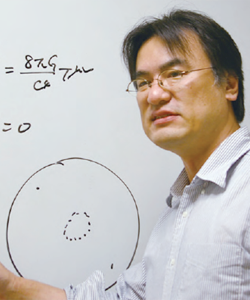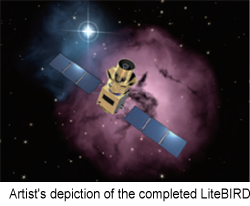Home > Research > Pickup > hirokazu_ishino
Solving the Mystery of the Universe Creation: An Approach from the Cosmic Microwave BackgroundSearch for the traces of primordial gravitational waves

Hirokazu Ishino
Professor of Physics
Hirokazu Ishino is a Professor in the Department of Physics, the Graduate School of Natural Science and Technology at Okayama University. He earned a B.S. from Tokyo Institute of Technology and a Ph.D. in experimental particle physics from the University of Tokyo. He was awarded a Research Fellowship for Young Scientists from the Japan Society for the Promotion of Science for his post-doctral work.
Professor Ishino shared the following anecdote: "When I was a child, I was impressed by this statement 'A black hole exists that can even swallow up light.' This sparked my interest in the universe and particles in it. How did the universe start? This is my eternal research theme." At Okayama University, Prof. Ishino is pursuing work on a scientific satellite project for ultrasensitive observations of the universe's cosmic microwave background. He hopes this will help to solve questions regarding the origins of the universe.
The cosmic microwave background (CMB) is the oldest light in the universe. It is the remnant of the division of light and matter that occurred 385,000 years after the birth of the universe. As the age of the universe is 13.8 billion years old, this light was produced at a very early stage after the Big Bang. It was only in 1964 that humans became aware of the existence of this ancient light. It was discovered by chance when two scientists, Arno Penzias and Robert W. Wilson, at Bell Laboratories in the United States, observed a slight but uninterrupted noise during an inspection of a radio astronomy antenna. The CMB became an extremely important object of research in studies of the origin of the universe and its founders shared the Nobel Prize in Physics in 1978.
"The CMB is called a 'fossil' of the universe. It contains a wealth of information on the beginnings of the cosmos." as spoken by Prof. Ishino, engaged in his research of solving the puzzles of the early universe.
Primordial gravitational waves and the cosmic inflation theory
The cosmic inflation theory[1] is based on the Big Bang theory. Cosmic inflation describes the enormous speed of expansion of the early universe after the Big Bang. Primordial gravitational waves (PGW) are predicted to be created at this time. The remnants of these waves should be contained within the CMB.
"What is important here," continues Prof. Ishino, "is that characteristic polarized light[2] is created within the CMB. Detailed investigation of this polarized light will give us knowledge of the strength of primordial gravitational waves."
Knowing the strength of PGW will make it possible to investigate the reasons for the occurrence of cosmic inflation. It is surprising that the scale of the physical energy to be investigated with this method is a trillion times larger than the physical energy studied with manmade high-speed accelerators! How to ascertain physical laws on such gigantic energy scales is a puzzle for modern physics. This study may also lead to verification of the grand unified theory (GUT), which seeks to unite the electromagnetic, weak, and strong forces into a single force.
LiteBIRD scientific satellite project

Prof. Ishino's research lab is currently engaged in the LiteBIRD scientific satellite project (see figure) as a means of investigating PGW using the CMB. This international project team includes a total of 100 researchers from Japan, America, Canada, Germany, and France. Prof. Ishino describes the project as follows.
"To accurately measure the strength of PGW, extremely high-sensitive detectors are needed. One needs the eye of a giant, that is capable of detecting a miniature light bulb somewhere in Nagoya or Fukuoka while standing in Okayama. Only superconducting detectors could make that possible." Superconducting detectors are currently the world's most sensitive detectors.
"Our lab is researching and developing superconducting detectors to pioneer a variety of aims in completely new sciences. Not only will we use these for observing the CMB, but we also expect future applications for investigating dark matter[3] , the development of large-area x-ray cameras having extreme energy resolution capabilities, for synchrotron radiation-related applications."
Join us at Okayama University as we seek the greatest discoveries in the history of humankind!
Finally, we asked Prof. Ishino to share a message with those seeking higher education.
"Within the next 10 to 20 years, physicists around the world will be intending to solve the secrets of the beginnings of the universe and ultimate laws of physics. These may likely become the greatest discoveries in the entire history of humankind. We hope that high school students will join us, so that they too may become participants working together with us as we challenge these mysteries!"
All have high expectations for LiteBIRD, as it sails into the universe with its approximately 2,000 extremely sensitive superconductive sensors to measure the CMB with ultimate sensitivity.
[1] This theory states that just after the birth of the universe, it expanded all at once from the size of a microscopic amoeba to that of an entire galaxy.
[2] "Polarized light" refers to light with the transverse oscillation confined in one plane, similar to the right- and left-handedness in humans.
[3] While dark matter has mass, it cannot be observed or measured using light directly.







